AI vs IoT: Which Drives Better Plant Growth Predictions?
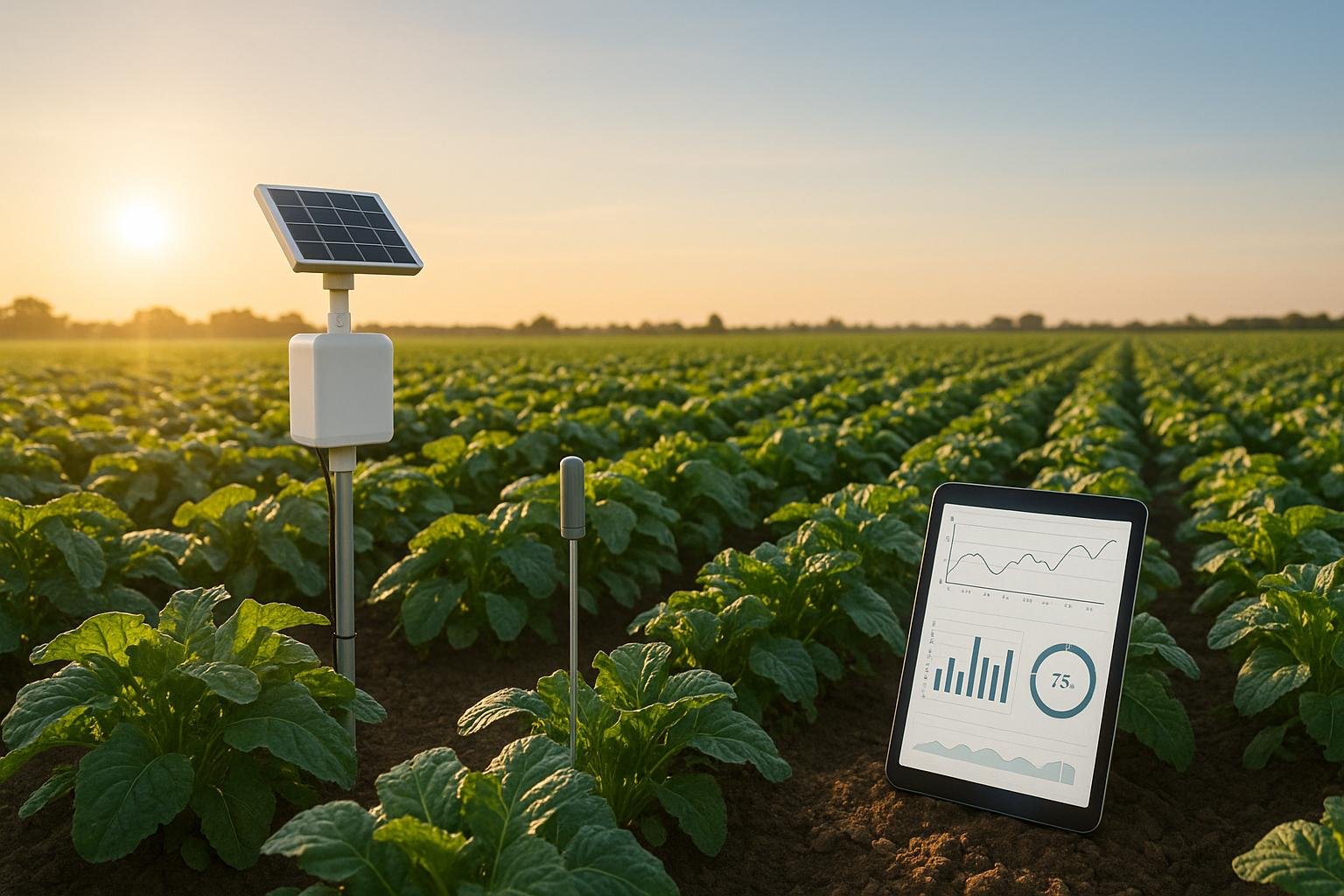
AI and IoT are transforming how plants are grown and managed. Here's the key takeaway: AI excels at analyzing historical data for long-term predictions, while IoT provides real-time monitoring and immediate actions. Together, they create a powerful system for smarter plant care and resource use.
- AI Strengths: Predicts crop yields, analyzes complex patterns, and improves over time. Examples include disease detection with ~94% accuracy and yield forecasting.
- IoT Strengths: Collects real-time data from sensors for immediate actions like irrigation adjustments, reducing water use by up to 30%.
- Combined Power: AI refines IoT data for better decisions, such as cutting water use by 20% while boosting crop yields by 30%.
Quick Comparison:
| Feature | AI | IoT |
|---|---|---|
| Data Type | Historical & complex data | Real-time sensor data |
| Key Use | Long-term predictions | Immediate actions |
| Cost | Software & infrastructure | Sensors & hardware |
| Maintenance | Algorithm updates | Sensor upkeep |
For large farms, combining AI and IoT maximizes efficiency. Smaller growers can start with IoT for daily care. Both technologies are shaping the future of agriculture, offering smarter ways to grow crops and manage resources.
Impact Of AI And IOT Technologies In Agriculture Farming | Smart Decision Taking Machines

How AI Works in Plant Growth Prediction
AI is revolutionizing the way we predict plant growth, offering data-driven insights that improve decision-making in agriculture. By employing machine learning algorithms, AI processes historical data to create predictive models that evolve over time. This approach shines a light on the role of deep learning, which uncovers intricate patterns within complex datasets that simpler methods often overlook.
Deep learning works by structuring raw data into multiple layers of abstraction, enabling it to identify relationships and structures that might otherwise go unnoticed. This hierarchical approach allows AI to extract meaningful insights from high-dimensional data, making it a powerful tool for understanding plant growth dynamics [4].
Several machine learning techniques have been particularly effective in this field, such as Long Short-Term Memory (LSTM) networks, Support Vector Regression (SVR), Random Forests (RF), Extreme Gradient Boosting (XGB), Support Vector Machines (SVM), and Deep Neural Networks (DNN). These methods have demonstrated their value in predicting crop yields and growth patterns [4] [5].
For example, studies show that deep learning provides stable predictions, such as accurately estimating corn yields in Iowa. Similarly, an XGB model achieved a root mean square error of just 8.88 grams when forecasting hydroponic lettuce yields [4] [5]. AI also excels at analyzing climate variables - like temperature shifts, rainfall, and extreme weather - linking them to yield outcomes. A 2022–2023 study in India, for instance, achieved R² scores as high as 0.92, showcasing AI's potential in handling climate-related complexities [6].
Main Benefits of AI
AI brings a host of advantages to plant growth prediction, transforming how agricultural data is analyzed and applied:
- Rapid data processing: AI can analyze massive datasets quickly, refining its predictions through continuous feedback. For instance, it can extract insights from over 1,750 genebanks worldwide, which collectively house more than 7 million germplasm accessions [3].
- Pattern recognition: Convolutional neural networks (CNNs) have been effectively used to process RGB images for root segmentation in crops like chicory, wheat, and rapeseed. They also assist in tasks like leaf counting, stress detection, and predicting spike numbers and yields in barley and wheat with impressive accuracy.
- Improving accuracy over time: AI systems become better with experience. As they process more data and receive feedback, their algorithms adjust to deliver more precise forecasts. This feature is especially valuable in agriculture, where conditions can vary dramatically from one season to the next.
- Handling complex interactions: Traditional methods often examine variables like soil moisture or temperature in isolation. AI, however, can analyze how dozens of factors interact simultaneously. Research highlights that temperature is a key variable affecting crop yields, but AI also uncovers significant interactions, such as those between rainfall and macronutrient levels [6].
- Speed and scalability: AI can process data from thousands of sensors across multiple locations in real time. This capability enables growers to access actionable insights without the need for labor-intensive manual analysis.
AI Limitations in Plant Growth Prediction
Despite its strengths, AI isn't without challenges when it comes to predicting plant growth. Its effectiveness relies heavily on the quality of input data - poor data can lead to inaccurate predictions, potentially harming crops.
The "black box" problem is another hurdle. While AI delivers highly accurate predictions, it often cannot explain the reasoning behind its conclusions. This lack of transparency can make farmers hesitant to trust AI-driven recommendations for critical decisions.
Connectivity issues also pose a challenge. Many agricultural operations lack reliable internet access or the infrastructure needed for real-time data streaming, limiting the effectiveness of AI systems in these environments.
High initial costs can deter smaller farms from adopting AI. Setting up these systems requires significant investment in sensors, computing equipment, and technical expertise for installation and maintenance.
AI also struggles with unprecedented conditions. While it excels at identifying patterns in historical data, it may falter when faced with entirely new scenarios, such as extreme weather events or the emergence of unfamiliar pests.
Finally, ongoing maintenance and expertise are necessary to keep AI systems running smoothly. Regular updates, monitoring, and troubleshooting require specialized knowledge - something not all growers have access to, especially in smaller or resource-limited operations.
How IoT Works in Plant Growth Prediction
The Internet of Things (IoT) is revolutionizing the way we predict plant growth by using interconnected sensors to gather real-time data on soil, air, and plant conditions. These sensors continuously monitor environmental factors and plant health, sending the collected data to central servers for analysis. This constant stream of information is the foundation for actionable insights that can improve agricultural practices.
The process starts with strategically placed sensors across growing areas. For example, soil moisture sensors measure water content, temperature sensors track both air and soil temperatures, and environmental sensors monitor factors like humidity, rainfall, and light intensity. Some advanced systems even include nutrient sensors to analyze vital soil components.
The data collected by these sensors is transmitted using wireless technologies. This flexibility means IoT systems can operate in a variety of settings, from urban greenhouses with strong internet connections to remote farms that rely on cellular or satellite networks.
What makes IoT so powerful is its ability to trigger automated actions based on sensor readings. For instance, smart irrigation systems can activate when soil moisture drops below a certain threshold, ensuring crops get the right amount of water. Similarly, environmental monitoring systems can alert farmers to conditions that may lead to disease outbreaks. In citrus orchards, for example, real-time soil data helps optimize irrigation and fertilization, reducing water waste and increasing productivity. Instead of relying on fixed schedules, watering is adjusted dynamically based on the actual needs of the soil.
The scale of IoT adoption in agriculture is growing rapidly. By 2024, over 75 million IoT devices are expected to be in use worldwide, and this number is projected to surpass 100 million by 2027. Looking further ahead, IoT could increase crop yields by 70% and save up to 50 billion gallons of water annually by 2050.
Main Benefits of IoT for Plant Monitoring
IoT offers several advantages for monitoring plant growth, thanks to its ability to collect and analyze data in real-time. Unlike traditional methods that rely on periodic manual checks, IoT sensors provide continuous updates, revealing trends and changes that might otherwise go unnoticed.
One major benefit is remote accessibility. Farmers can monitor key metrics like water levels, temperature, and humidity from anywhere using their smartphones or computers. This is particularly useful for managing large farms or multiple locations without needing to be physically present.
IoT also enables precise interventions. For example, soil moisture sensors help determine the exact timing and amount of water needed, preventing both over-watering and under-watering. Environmental sensors can detect early signs of stress or disease, allowing farmers to take action before problems escalate.
Cost savings are another key advantage. By optimizing the use of resources like water and fertilizers, IoT systems reduce waste and lower expenses. Automated irrigation systems, for instance, only deliver water when it’s needed, while nutrient sensors help avoid over-fertilization, which saves money and protects the environment.
Automation further reduces labor demands and minimizes human error. Smart systems can operate independently based on sensor data, freeing up time for other essential tasks. Moreover, the wealth of data generated by IoT devices supports data-driven decision-making, helping farmers plan more effectively for the future.
IoT Implementation Challenges
Although IoT offers many benefits, it also comes with challenges that can hinder adoption. One of the biggest obstacles is the high upfront cost. Setting up an IoT system involves expenses for sensors, connectivity, data platforms, and installation. For instance, soil moisture sensors can cost anywhere from $50 to $300, weather stations range from $100 to several thousand dollars, and nutrient sensors can cost between $500 and $2,000. Agricultural drones, depending on their features, can range from $1,000 to over $25,000.
Connectivity is another hurdle, especially in rural or remote areas where stable internet infrastructure is often lacking. Without reliable data transmission, IoT devices struggle to communicate with central systems.
Managing the large volumes of data generated by IoT systems can also be overwhelming. Effective analysis requires advanced tools and expertise, which not all farmers have access to.
Security is a growing concern as well. IoT devices can be vulnerable to cyberattacks due to weak encryption, outdated software, or insufficient user authentication measures.
Finally, technical complexity and the need for ongoing maintenance can deter farmers from adopting IoT. Integrating these systems often requires significant changes to existing workflows and equipment. Compatibility issues between different IoT devices and platforms can further complicate implementation, reducing efficiency and creating additional challenges.
🚀 Ready to Reinvent Your Garden?
Join thousands of homeowners who have transformed their gardens using our AI design tool. Upload one photo to explore endless possibilities.
Get your AI garden designs →AI vs IoT: Direct Comparison
Understanding the distinctions between AI and IoT technologies is key to deciding which approach suits specific plant growth prediction needs. Both play unique roles in modern agriculture, each offering its own set of advantages.
Side-by-Side Feature Comparison
Here’s a quick look at how AI and IoT differ in their application to plant growth prediction:
| Feature | AI Technology | IoT Technology |
|---|---|---|
| Data Processing | Analyzes historical patterns and large datasets | Collects real-time sensor data |
| Prediction Type | Long-term forecasting and pattern recognition | Immediate alerts based on current conditions |
| Accuracy Range | 94–98% for disease detection and about 91% for soil moisture prediction | Varies with sensor quality and environmental factors |
| Initial Investment | Primarily software licensing and computing infrastructure | Often requires upfront investment in sensors and hardware |
| Maintenance | Involves regular model updates and data management | Involves physical sensor upkeep and calibration |
| Connectivity | Requires periodic data uploads | Often relies on continuous network connection |
AI thrives on historical data, leveraging machine learning to identify complex patterns and make predictions. On the other hand, IoT focuses on real-time monitoring by streaming data directly from sensors.
For example, AI demonstrates high accuracy in areas like disease detection and yield forecasting [2][7]. Meanwhile, IoT excels in delivering immediate updates for real-time applications, such as environmental monitoring [7].
From a cost perspective, AI's expenses are often tied to software and computing infrastructure, while IoT demands upfront hardware investments, such as sensors and networking equipment.
When to Choose AI, IoT, or Both
The choice between AI, IoT, or a combination of both depends on your farm's size, goals, and operational needs.
Large-scale commercial farms often benefit from advanced systems that integrate optical and electromagnetic sensors with UAVs or satellites. These setups provide detailed, spatially continuous insights but require significant capital, a strong network infrastructure, and skilled personnel for data interpretation [1].
Smaller farms or individual growers tend to lean toward simpler, cost-effective solutions like soil moisture probes or low-cost IoT water sensors. These tools are easy to install and provide actionable, on-site data [1].
- AI is best suited for long-term planning, disease prediction, and yield forecasting. It uncovers hidden patterns in agricultural data, as seen in the PACMAN SCRI project. This initiative uses digital technologies to optimize apple crop load management, improving yield, fruit quality, and profitability [2].
- IoT shines in scenarios requiring immediate responses, such as automated irrigation or constant environmental monitoring.
For maximum impact, combining AI and IoT is the way to go. AI’s analytical capabilities paired with IoT’s real-time data collection create a powerful system that can provide both immediate alerts and long-term insights.
This trend is reflected in the agricultural technology market. In 2020, the global agricultural robot market was valued at $4.9 billion and is projected to grow to $11.9 billion by 2026 [2].
For home gardeners or small-scale growers, IoT sensors are often the go-to choice for daily plant care. Meanwhile, commercial operations gain more value from AI-driven tools for planning and resource allocation. Together, AI and IoT can adapt to both short-term needs and strategic, long-term goals.
sbb-itb-4d6a8dd
Combined AI-IoT Solutions and Real Applications
When AI and IoT come together, they create a powerful synergy that combines real-time monitoring with intelligent analysis. This partnership allows for quick responses and strategic insights, particularly in areas like plant growth prediction. By blending these technologies, farmers can make more informed decisions, improving resource management and boosting crop yields.
Benefits of Combining AI and IoT
The integration of AI and IoT paves the way for more precise and dynamic farming techniques[10]. IoT sensors consistently gather data on critical factors like soil moisture, temperature, humidity, and plant health. AI steps in to process this data, uncover patterns, and make predictions. While IoT ensures constant monitoring, AI enhances it with predictive analytics, enabling smarter resource allocation and real-time decision-making[10].
Take water management as an example: IoT-enabled irrigation systems can cut water use by more than 30% by relying on real-time data. Meanwhile, AI anticipates plant water needs by analyzing weather forecasts, growth stages, and historical trends[10].
"AI is really good at cleaning up dirty data... Water sensors get stuck. Aerial imagery captures clouds. Every data source, every sensor has its little challenges." - Mike Flaxman, Vice President of Product, HEAVY.AI[9]
This quote underscores AI's ability to refine imperfect IoT data, ensuring that the insights remain reliable and actionable.
Real Examples of Combined Solutions
The real-world applications of AI-IoT integrations showcase their potential to tackle both immediate and long-term agricultural challenges.
For instance, a California vineyard used AI to fine-tune nitrogen application and irrigation schedules. The result? A 25% increase in production coupled with a 20% reduction in water usage. Similarly, a large-scale farming operation in California combined soil moisture sensors, weather stations, and drone imagery with AI analysis. This approach led to a 30% decrease in water usage and a 20% boost in yield within just one growing season[11].
In the Midwest, an agri-tech company utilized drones equipped with IoT sensors and AI-powered image analysis for crop surveillance. This targeted approach reduced fertilizer use by 25%, as it precisely identified areas that required nutrients[11].
The PACMAN SCRI project is another example, focusing on specialty crops like apples. By integrating computer vision, AI, and machine learning, the project optimizes crop load management, improving yield, fruit quality, size, and overall orchard profitability[2].
Even livestock operations are seeing the benefits. A Texas farm enhanced herd productivity by 15% using wearable IoT devices paired with AI. This system tracks animal behavior, feeding patterns, and health indicators, allowing farmers to predict and address issues before they escalate[11].
For home gardeners and landscapers, tools like AIGardenPlanner offer smart solutions. By analyzing uploaded garden photos and local climate data, the platform provides tailored plant recommendations and design suggestions, helping users make better gardening decisions.
The adoption of these integrated systems is on the rise. The AI in agriculture market is projected to grow from $1.7 billion in 2023 to $4.7 billion by 2028[8]. With their ability to enhance efficiency and productivity, AI-IoT solutions are quickly becoming essential investments for modern farming.
Summary and Future of Plant Growth Prediction
Main Points
When it comes to predicting plant growth, AI and IoT create a powerful combination. IoT excels at real-time monitoring, continuously tracking vital metrics like soil moisture and temperature. Meanwhile, AI takes both historical and real-time data and turns it into predictions that can guide smarter decisions. Together, they create a system that not only monitors but also forecasts, enabling automated actions that can improve farming efficiency[12].
For example, IoT can instantly adjust irrigation systems based on soil moisture levels, making immediate changes to optimize water use. On the other hand, AI dives deeper, helping farmers plan strategically - whether it’s determining the best planting times, identifying potential disease outbreaks, or optimizing how resources are allocated. The numbers back up this tech revolution: the AI in agriculture market is expected to hit $2.6 billion by 2025[14], while the broader AgTech sector, valued at $26 billion today, could grow to $74 billion by 2034[13]. By 2025, over 80% of new farm equipment will come equipped with AI-powered sensors for real-time monitoring[12]. Clearly, these advancements are setting the stage for the next era of smart farming.
Future Technology Developments
Looking ahead, the possibilities for plant growth prediction are even more exciting. AI is evolving rapidly, with advanced algorithms now capable of analyzing complex environmental patterns to predict plant behavior with even greater accuracy. Companies like Prospera Technologies and CropX are already using tools like drone imagery and real-time soil analysis, combined with AI, to improve crop health and fine-tune resource use - all while cutting labor costs and reducing reliance on chemical inputs[13].
The potential impact is massive. By 2025, AI-powered smart farming could increase global crop yields by up to 30% and cut water usage by 20%[16]. The financial outlook is just as promising, with the AI and data segments of AgTech projected to reach $4.9 billion by 2030, growing at a rate of 24.1% annually[13].
Sustainability is also at the forefront of these developments. Future innovations are likely to include more advanced AI models, crops designed to withstand climate challenges, and the use of blockchain to ensure transparency in farming operations. The integration of AI with edge computing, 5G networks, and robotics will continue to reshape agriculture, making it smarter and more sustainable than ever[15][16].
These advancements aren’t just for large-scale farms. Home gardeners and small-scale growers are also benefiting from this tech wave. Platforms like AIGardenPlanner can analyze photos of your garden and local climate data to offer tailored planting advice and design ideas. Beyond traditional farming, these technologies are finding applications in areas like carbon trading and biodiversity protection. As carbon markets and biodiversity credits gain traction, AI-powered platforms will play a critical role in promoting environmental accountability and stewardship[16].
FAQs
How do AI and IoT work together to improve plant growth predictions?
🎨 Visualize Your Dream Garden Today!
Transform any outdoor space into a professional landscape design in minutes. Just upload a photo, choose your style, and let our AI do the rest.
Start your garden transformation now →How AI and IoT Are Transforming Plant Growth Predictions
AI and IoT are teaming up to change the way we predict plant growth. IoT devices, such as sensors, gather real-time data on critical factors like soil moisture, temperature, light levels, and other environmental conditions. Once this data is collected, AI steps in to analyze it, uncover patterns, forecast growth trends, spot potential plant diseases, and suggest ways to optimize resources.
By combining the precision of IoT’s data collection with AI’s powerful analytical tools, growers can make smarter, data-backed decisions. This partnership not only boosts the accuracy of predictions but also promotes gardening practices that are both efficient and environmentally friendly.
What challenges do AI and IoT face in agriculture, and how can they be overcome?
AI and IoT in agriculture face a variety of hurdles, making it tough for many farmers - especially those with smaller operations - to adopt these technologies. Some of the biggest challenges include limited technical knowledge among farmers, high upfront costs, poor internet connectivity in rural areas, data security concerns, and the pressing need for modernized infrastructure.
There are, however, ways to tackle these obstacles. For example, satellite-based internet services like Starlink or low-power wide-area networks (LoRaWAN) can bring reliable connectivity to even the most remote areas. To make these technologies more accessible, developing affordable, easy-to-use tools and offering hands-on training programs can bridge the knowledge gap. On top of that, robust cybersecurity measures are essential - not just to protect sensitive data but also to build trust among users. By prioritizing accessibility and security, AI and IoT can move closer to becoming practical, everyday tools for improving agricultural productivity.
Should small-scale farmers start with AI or IoT for better plant growth predictions?
For small-scale farmers, diving into IoT (Internet of Things) can be a smart starting point. These devices deliver real-time updates on crucial factors like soil moisture, temperature, and surrounding conditions. With this instant feedback, farmers can manage their resources more efficiently and make timely decisions - critical for operations working with tighter budgets.
After setting up IoT systems to gather useful data, the next step is introducing AI (Artificial Intelligence). AI can analyze patterns, improve predictions, and provide deeper insights based on the data collected. By beginning with IoT and gradually integrating AI, small-scale farmers can create a budget-friendly, scalable system that enhances plant growth and boosts overall productivity.
Related posts
Related Articles
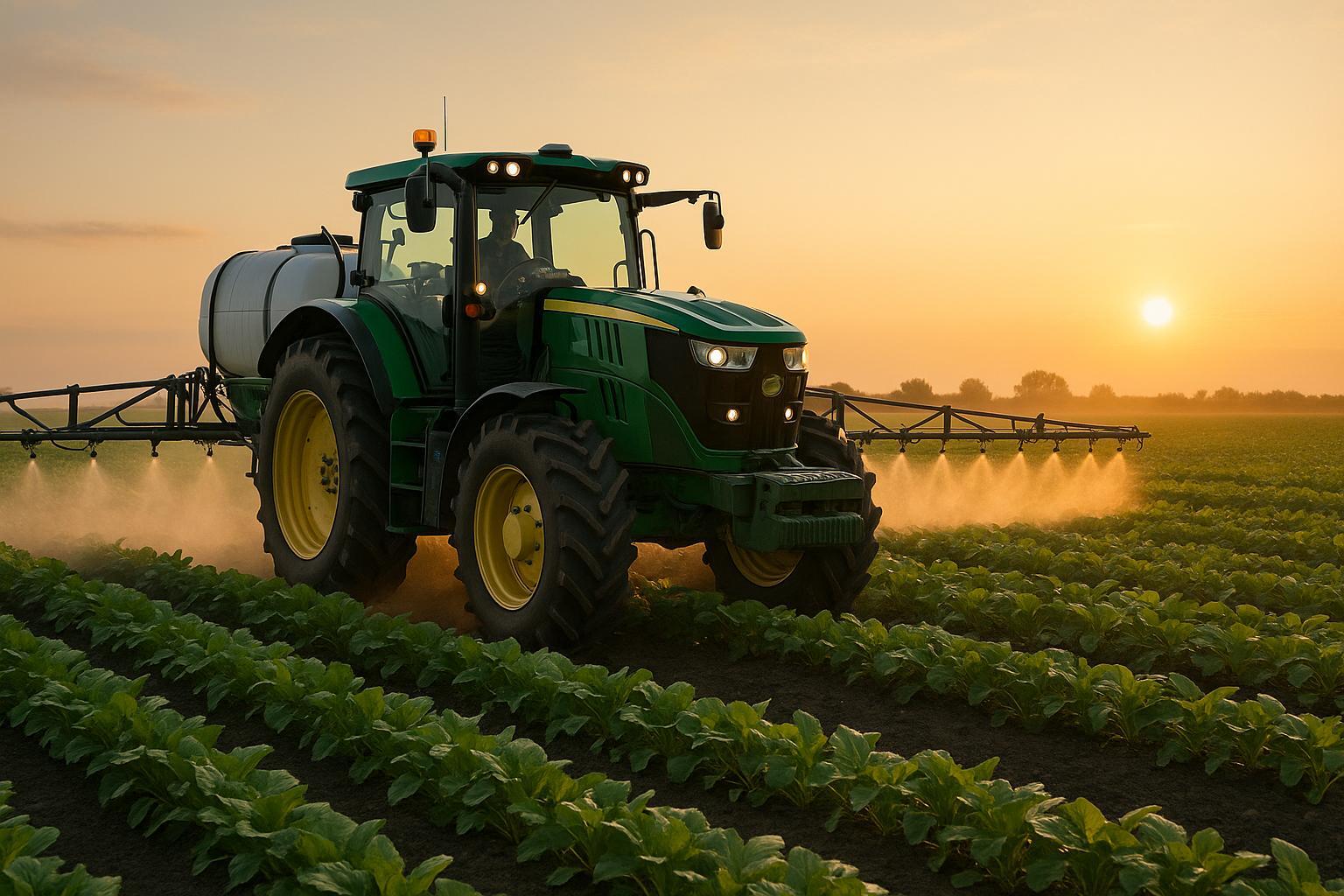
Variable Rate Spraying: Key Performance Metrics
Explore how Variable Rate Spraying optimizes pesticide use, enhancing efficiency and sustainability while reducing costs and environmental impact.
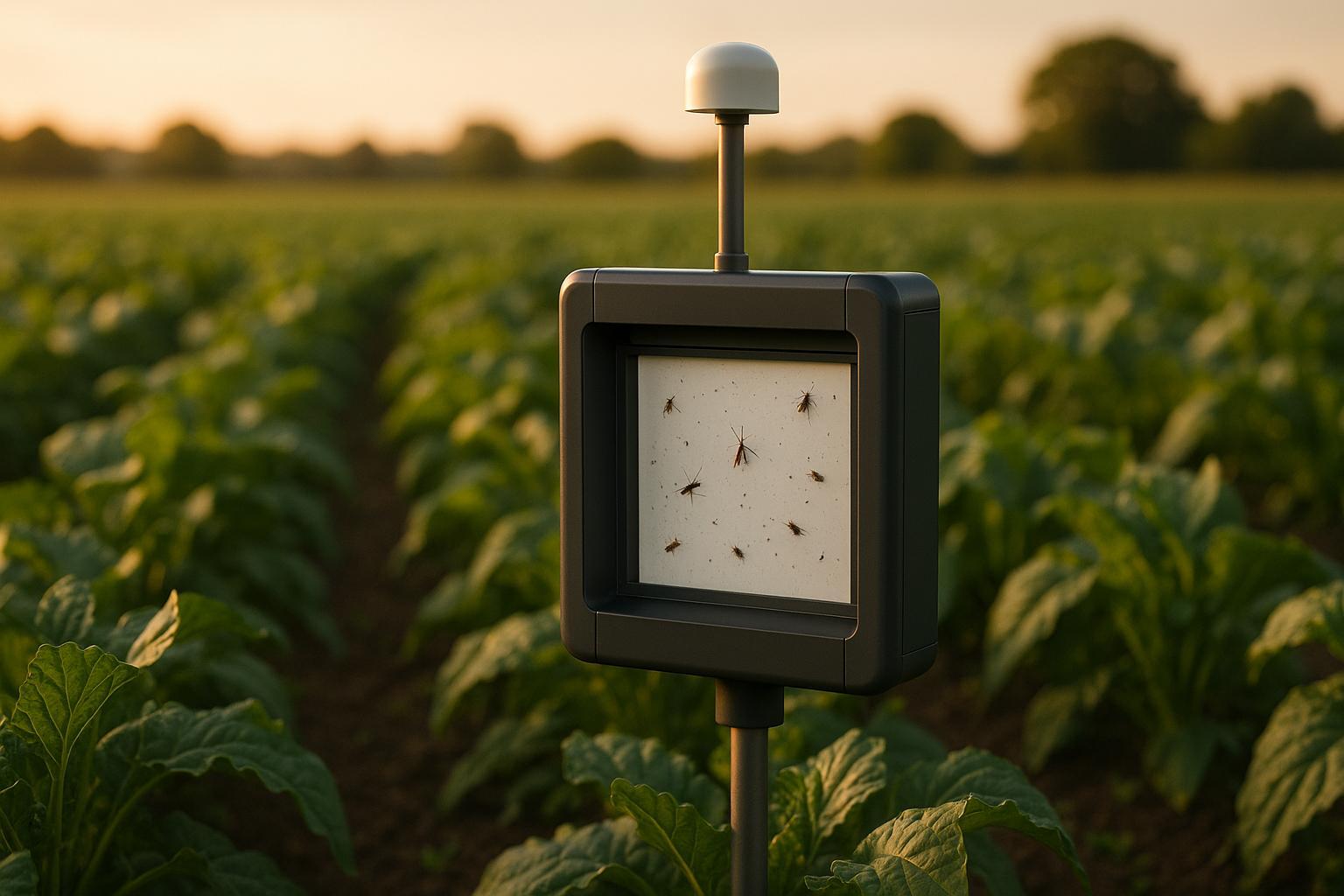
5 Calibration Tips for Remote Pest Monitoring Systems
Learn essential calibration tips for remote pest monitoring systems to enhance accuracy, reduce pesticide usage, and improve crop management.

Effective Gardening Tool Storage Solutions: Wall-Mounted Racks, Sheds, and Cabinets
Keep your gardening tools organized and easily accessible with these effective gardening tool storage solutions. Learn about wall-mounted racks, garden sheds, and storage cabinets.
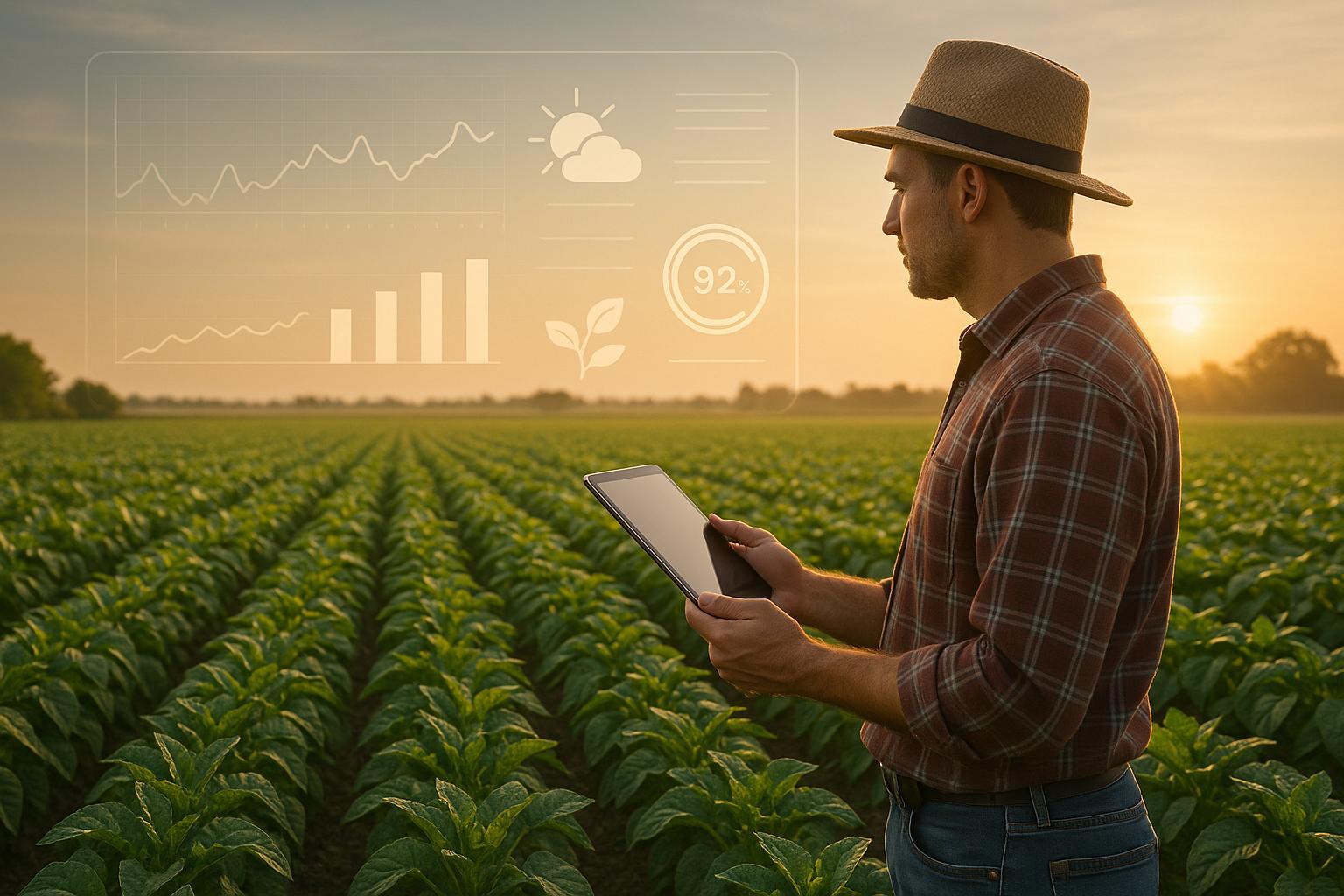
How Disease Prediction Models Reduce Crop Loss
AI-driven disease prediction models help farmers reduce crop losses, optimize resource use, and improve yields through early detection and actionable insights.
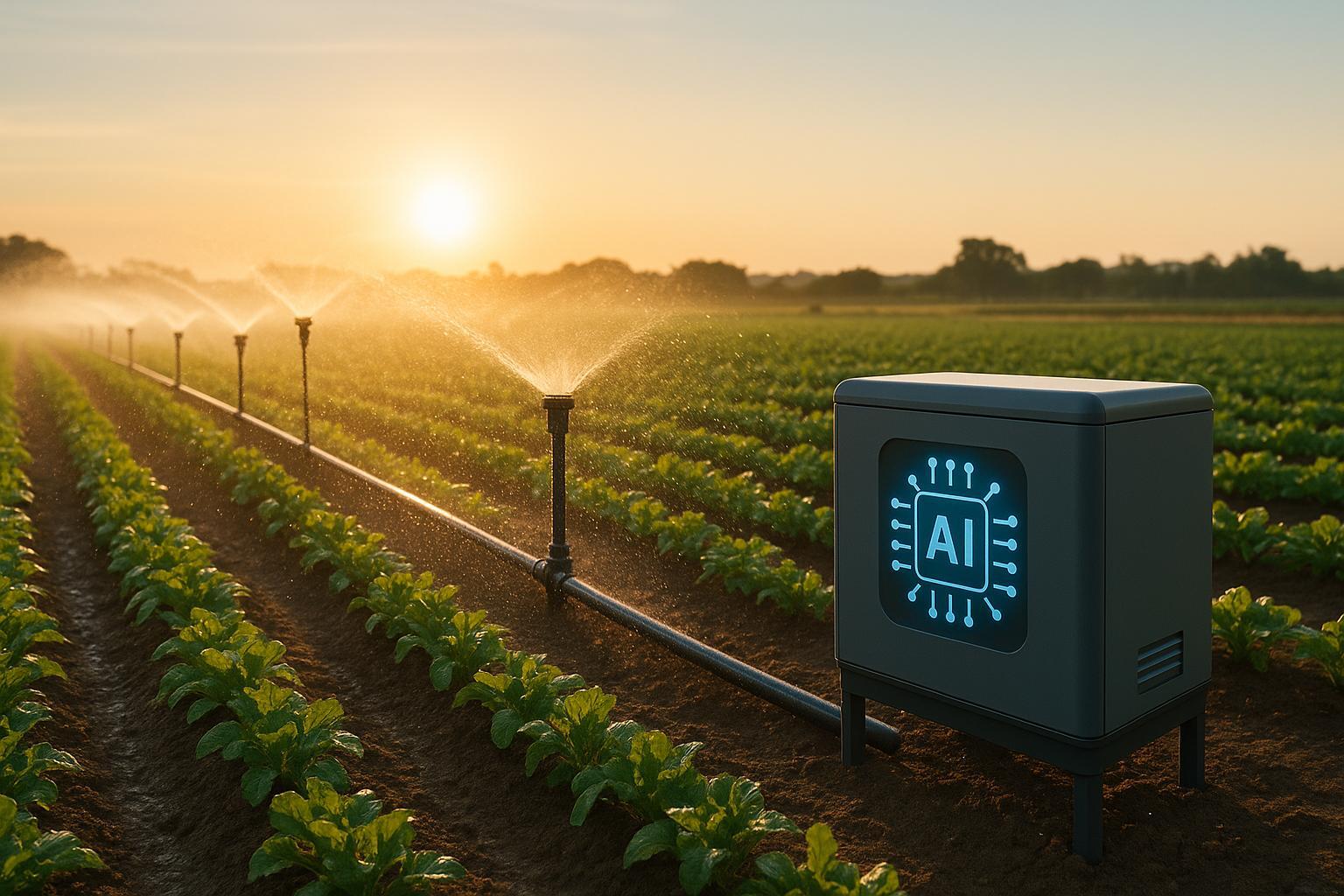
5 Common Irrigation Problems AI Solves
AI-powered irrigation systems tackle common issues like water waste and uneven distribution, promoting healthier plants and reducing costs.
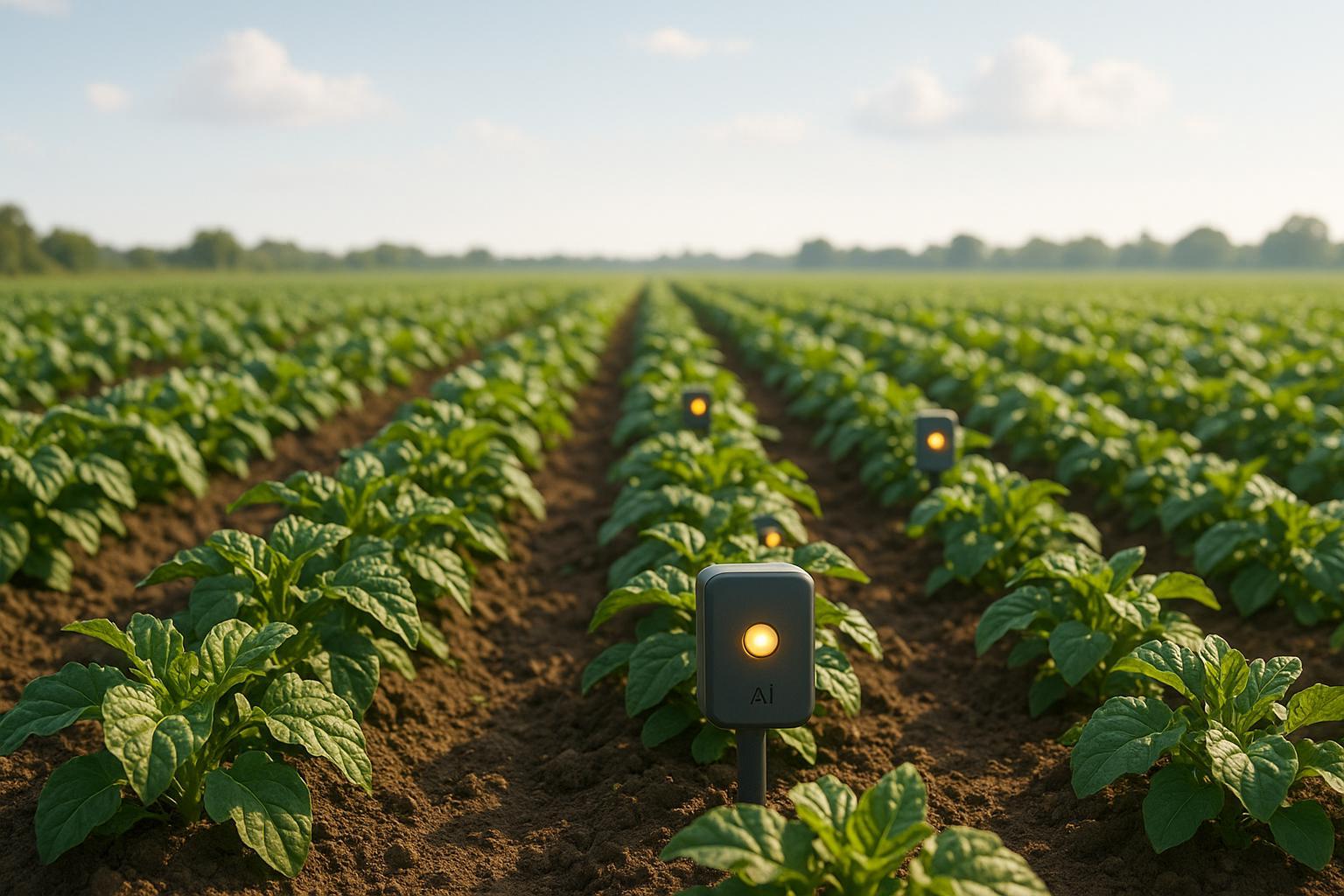
How AI Sensors Improve Seasonal Plant Monitoring
Explore how AI sensors revolutionize plant monitoring, enhancing resource efficiency, boosting yields, and enabling early disease detection.